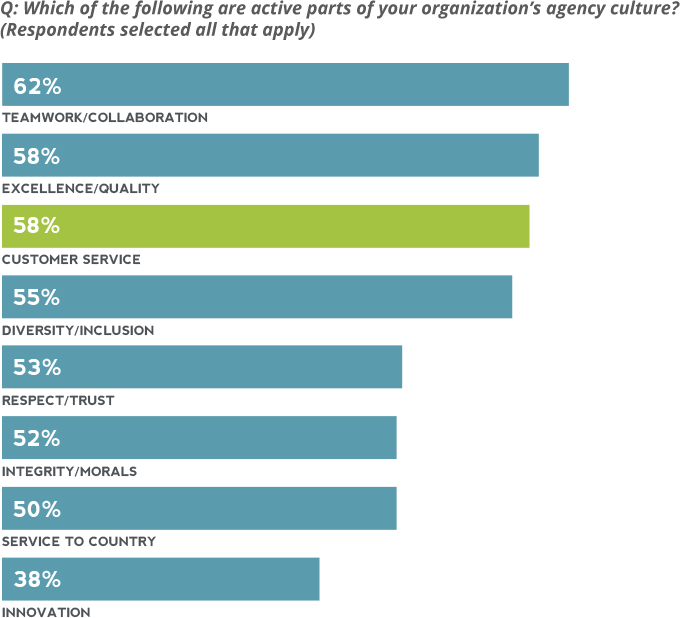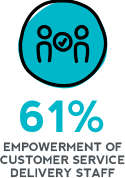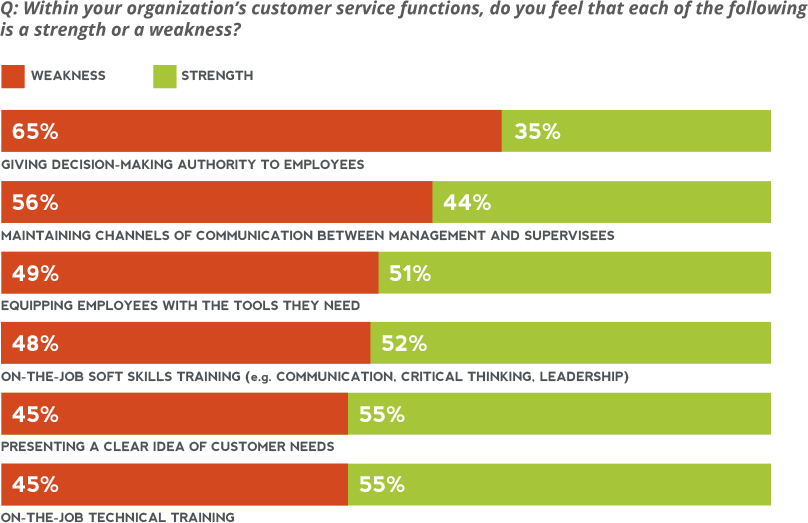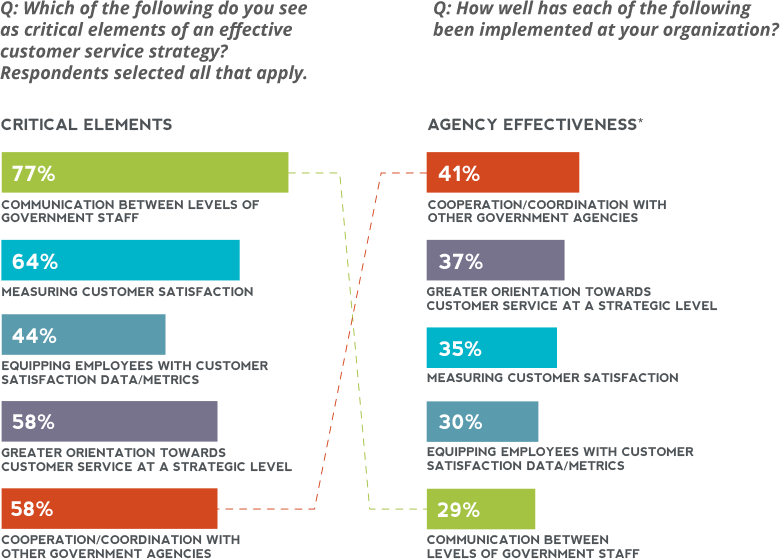Report
Improving customer service in federal government: Culture or budget

Enhancing workplace morale is the aspect of customer service most frequently identified as a driver of improved customer service in the federal government.
Eagle Hill Consulting recently undertook a survey of federal employees to gain a straightforward perspective on the challenges and opportunities for improving government customer service—from those operating right at its core. With OMB Circular A-11’s customer experience (CX) maturity model as our framework, Eagle Hill is providing a series of recommendations, based on our discoveries, for agencies to apply right away.
In this article, we focus on how to build a workplace culture in which excellent customer service can flourish.
OMB Circular A-11 Section 280: What it Means for Government Customer Service
OMB Circular A-11 Section 280 gives guidance for agencies to enhance the customer experience (CX). By focusing on improvements in five core functions of the CX maturity model—measurement, governance and strategy, culture and organization, customer understanding, and service design—it’s intended to make CX across government more consistent, comprehensive, and robust.
Source: OMB Circular A-11 Section 280
When it comes to government customer service, “soft skills” make the difference
Eagle Hill’s survey shows that federal agencies and their employees already seem to recognize the link between internal culture and customer service: currently, 58 percent of respondents identify customer service as an active part of their organization’s culture (Figure 1).
Figure 1: A majority of federal employees identify customer service as an active part of their workplace culture

Source: The 2018 Eagle Hill Consulting Federal Government Customer Service Survey
At the same time, specific cultural elements receive much less focus than their customer service impact would seem to warrant. For example, our survey respondents were most likely to point to workplace cultural elements as important to improving CX. The factors that respondents most often cited as having significant impact on customer service are enhanced workplace morale (69 percent) and empowerment of customer service staff (61 percent). Significantly, “soft skill” factors were rated more highly by employees than either improved information technology or additional financial resources (Figure 2). The data here adds weight to Eagle Hill’s contention that improving government customer service does not presuppose costly investments.
Figure 2: Employees rank workplace culture factors as more important to improving customer service than resource-intensive factors, such as improved IT or extra budget
Q: Which of the following would significantly improve customer service in the federal government? (Respondents selected all that apply)




Source: The 2018 Eagle Hill Consulting Federal Government Customer Service Survey
Despite workplace culture’s importance to customer service, it is not reflected in the current reality. Respondents identify specific cultural elements that come up short within the customer service function. Giving decision-making authority to employees ranks as the top weakness, with maintaining channels of communication between management and supervisees the second largest weakness (Figure 3). Interestingly, these are the only two factors that federal employees were more likely to cite as a weakness than a strength (although none of the factors emerged as particularly “strong”).
Figure 3: Federal employees say the #1 weakness in customer service functions is giving decision-making authority to employees

Source: The 2018 Eagle Hill Consulting Federal Government Customer Service Survey
Federal employees want to be more empowered to improve customer service. They want to contribute to the customer service conversation. Yet more than half (56 percent) of the respondents say their organization does not seek employees’ ideas on improving customer service.
Eagle Hill has seen this trend before. Our 2017 survey and report, “Building an Ideas Culture in Federal Government,” found that 72 percent of federal employees say that their agency “rarely or never seeks their ideas for improvements” in general. (You can find that report, which also provides recommendations for developing a culture that promotes employee ideas, here.)
Overall, our survey found a mismatch between how employees rate the factors critical to customer service and their agency’s effectiveness in these areas (Figure 4). In this figure we also highlight the fact that federal employees were most likely to rate cooperation/coordination with other government agencies as the area where their agency is effective. With the President’s Management Agenda’s focus on “improving customer experience” as a cross-cutting priority and its heavy emphasis on how coordination within and among agencies is fundamental to making improvements, agencies should continue to build on this relative strength and seek more opportunities to collaborate for citizen-centered, holistic service.
Figure 4: There is a mismatch between key factors employees say are critical to customer service, and how they rate effectiveness

Source: The 2018 Eagle Hill Consulting Federal Government Customer Service Survey
Engage your employees to ignite customer service improvements.
The recent Wall Street Journal article, “A Company’s Performance Depends First of All on Its People,” reported that “the biggest jumps in the Drucker Institute’s ranking of best-managed businesses were at companies with big gains in employee engagement and development” (Rick Wartzman and Lawrence Crosby, August 12, 2018). Eagle Hill Consulting proposes that the idea of increasing employees’ engagement as a path to improvement holds true in government as well.
Our survey findings indicate that CX improvements may rely less on pricey technology upgrades than on relatively low-cost culture improvements—namely, the space and encouragement to innovate and the recognition and reward for jobs well done. We believe these conclusions should encourage agencies, as culture improvements are a lever agencies can begin to move right away.
The criticality of culture to customer service further supports our earlier recommendation: federal agencies would do well to consider instituting a single customer service lead. Figure 5 makes the case clearly. Only 40 percent of employees in agencies without a customer service lead say their agency seeks employee ideas on how to improve customer service. When an agency has a single customer service lead, however, the positive response rate increases to 63 percent. Likewise, employees in an agency with a single customer service lead are significantly more likely than employees in an agency without a single lead to say that customer service is an active part of their culture.
Figure 5: Having a single customer service lead corresponds with increased adoption of elements critical to the improvement of customer service

* Does your agency solicit employees’ ideas on improving customer service? (yes/no)
** Which of the following are active parts of your organization’s agency culture? Please select all that apply.
Source: The 2018 Eagle Hill Consulting Federal Government Customer Service Survey
Methodology
The 2018 Eagle Hill Consulting Federal Government Customer Service Survey was conducted online by Government Business Council between June and July 2018. The online survey included 625 respondents from a random sample of respondents across the Federal Government (including civilian and Department of Defense agencies).
Go here to follow the series.

